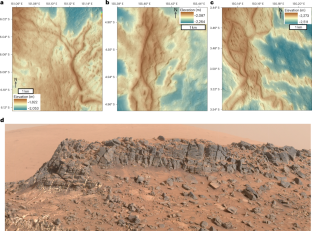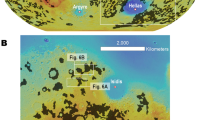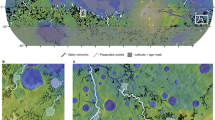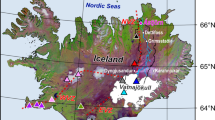Abstract
Large sedimentary basins contain archives of Earth history. It is unknown to what extent similar basins existed on Mars because there are few observations relating to the subsurface and it is difficult to identify buried deposits. Here, we used numerical simulations to show that landscapes of networks of topographic ridges that are abundant on the surface of Mars may represent erosional windows into thick, basin-filling river deposits that accumulated over long time spans. We used a numerical model to drive hillslope creep and differential erosion from the wind to simulate Mars-like exhumation processes acting on basin-filling fluvial strata, which we based on those buried in the Gulf of Mexico on Earth, as imaged using three-dimensional reflectance seismology. Simulations produced remarkably Martian landscapes in which the preferential erosion of mudstone relative to sandstone channel belts leads to the development of complex patterns of intersecting ridges. Our findings contrast to the existing view of ridged Martian landscapes as thin-skinned surface deposits preserving fluvial landscapes at a snapshot in time. Instead, the ridge cross-cutting patterns produced by the model reflect the exhumation of channel bodies at different stratigraphic levels, exposing basin strata accumulated over time scales of 500,000 years. Thus, we propose that fluvial ridges on Mars may expose an archive of long-lived aqueous processes.
This is a preview of subscription content, access via your institution
Access options
Access Nature and 54 other Nature Portfolio journals
Get Nature+, our best-value online-access subscription
$29.99 / 30 days
cancel any time
Subscribe to this journal
Receive 12 print issues and online access
$259.00 per year
only $21.58 per issue
Buy this article
- Purchase on Springer Link
- Instant access to full article PDF
Prices may be subject to local taxes which are calculated during checkout




Similar content being viewed by others
Data availability
The 3D seismic volume used to generate the experimental results is available in Caltech’s Research Data Repository74.
Code availability
The numerical model used in the experiments is available in Caltech’s Research Data Repository74.
References
Foreman, B. Z., Heller, P. L. & Clementz, M. T. Fluvial response to abrupt global warming at the Palaeocene/Eocene boundary. Nature 491, 92–95 (2012).
Paola, C. Quantitative models of sedimentary basin filling. Sedimentology 47, 121–178 (2000).
Nyberg, B. & Howell, J. A. Is the present the key to the past? A global characterization of modern sedimentary basins. Geology 43, 643–646 (2015).
McMahon, W. J. & Davies, N. S. Evolution of alluvial mudrock forced by early land plants. Science 359, 1022–1024 (2018).
Simms, A. R., Anderson, J. B., Milliken, K. T., Taha, Z. P. & Wellner, J. S. Geomorphology and age of the oxygen isotope stage 2 (last lowstand) sequence boundary on the northwestern Gulf of Mexico continental shelf. Geol. Soc. Lond. Spec. Publ. 277, 29–46 (2007).
Cloud, P. Paleoecological significance of the banded iron-formation. Econ. Geol. 68, 1135–1143 (1973).
Summons, R. E. et al. Preservation of Martian organic and environmental records: final report of the Mars Biosignature Working Group. Astrobiology 11, 157–181 (2011).
McMahon, S. et al. A field guide to finding fossils on Mars. J. Geophys. Res. Planets 123, 1012–1040 (2018).
Goudge, T. A., Mohrig, D., Cardenas, B. T., Hughes, C. M. & Fassett, C. I. Stratigraphy and paleohydrology of delta channel deposits, Jezero Crater, Mars. Icarus 301, 58–75 (2018).
Grotzinger, J. P. et al. Deposition, exhumation, and paleoclimate of an ancient lake deposit, Gale Crater, Mars. Science 350, aac7575–aac7575 (2015).
Irwin, R. P., Lewis, K. W., Howard, A. D. & Grant, J. A. Paleohydrology of Eberswalde Crater, Mars. Geomorphology 240, 83–101 (2015).
Dickson, J. L., Lamb, M. P., Williams, R. M. E., Hayden, A. T. & Fischer, W. W. The global distribution of depositional rivers on early Mars. Geology 49, 504–509 (2020).
Grotzinger, J. P. & Milliken, R. E. Sedimentary geology of Mars. Society for Sedimentary Geology https://doi.org/10.2110/pec.12.102 (2012).
Malin, M. C. & Edgett, K. S. Mars Global Surveyor Mars Orbiter Camera: interplanetary cruise through primary mission. J. Geophys. Res. 106, 23429–23570 (2001).
Malin, M. C. & Edgett, K. S. Evidence for persistent flow and aqueous sedimentation on early Mars. Science 302, 1931–1934 (2003).
Edgett, K. S. et al. Extraformational sediment recycling on Mars. Geosphere https://doi.org/10.1130/GES02244.1 (2020).
Edgett, K. S. & Sarkar, R. Recognition of sedimentary rock occurrences in satellite and aerial images of other worlds—insights from Mars. Remote Sens. 13, 4296 (2021).
Carter, L. M. et al. Shallow radar (SHARAD) sounding observations of the Medusae Fossae Formation, Mars. Icarus 199, 295–302 (2009).
Banerdt, W. B. et al. Initial results from the InSight mission on Mars. Nat. Geosci. 13, 183–189 (2020).
Williams, R. M. E., Jr, Thomas, C. C. & Eby, D. E. Exhumed paleochannels in central Utah—analogs for raised curvilinear features on Mars. in Central Utah: Diverse Geology of a Dynamic Landscape 221–235 (Utah Geological Association, 2007).
Cardenas, B. T., Mohrig, D. & Goudge, T. A. Fluvial stratigraphy of valley fills at Aeolis Dorsa, Mars: evidence for base-level fluctuations controlled by a downstream water body. GSA Bull. 130, 484–498 (2018).
DiBiase, R. A., Limaye, A. B., Scheingross, J. S., Fischer, W. W. & Lamb, M. P. Deltaic deposits at Aeolis Dorsa: sedimentary evidence for a standing body of water on the northern plains of Mars. J. Geophys. Res. Planets 118, 1285–1302 (2013).
Hayden, A. T. et al. Formation of sinuous ridges by inversion of river-channel belts in Utah, USA, with implications for Mars. Icarus 332, 92–110 (2019).
Balme, M. R. et al. Aram Dorsum: an extensive mid-Noachian age fluvial depositional system in Arabia Terra, Mars. J. Geophys. Res. Planets 125, e2019JE006244 (2020).
Stack, K. M. et al. Evidence for plunging river plume deposits in the Pahrump Hills member of the Murray Formation, Gale Crater, Mars. Sedimentology 66, 1768–1802 (2019).
Day, M. & Kocurek, G. Observations of an aeolian landscape: from surface to orbit in Gale Crater. Icarus 280, 37–71 (2016).
Hayden, A. T. & Lamb, M. P. Fluvial sinuous ridges of the Morrison Formation, USA: meandering, scarp retreat, and implications for mars. J. Geophys. Res. Planets 125, e2020JE006470 (2020).
Cardenas, B. T. et al. The anatomy of exhumed river-channel belts: bedform to belt-scale river kinematics of the Ruby Ranch Member, Cretaceous Cedar Mountain Formation, Utah, USA. Sedimentology 67, 3655–3682 (2020).
Zaki, A. S., Pain, C. F., Edgett, K. S. & Castelltort, S. Global inventory of fluvial ridges on Earth and lessons applicable to Mars. Earth Sci. Rev. 216, 103561 (2021).
Butcher, F. E. G., Conway, S. J. & Arnold, N. S. Are the Dorsa Argentea on Mars eskers? Icarus 275, 65–84 (2016).
Bleacher, J. E. et al. Plateaus and sinuous ridges as the fingerprints of lava flow inflation in the Eastern Tharsis Plains of Mars. J. Volcanol. Geotherm. Res. 342, 29–46 (2017).
Milliken, K. T., Blum, M. D., Snedden, J. W. & Galloway, W. E. Application of fluvial scaling relationships to reconstruct drainage-basin evolution and sediment routing for the Cretaceous and Paleocene of the Gulf of Mexico. Geosphere 14, 749–767 (2018).
Hart, B. S. Channel detection in 3-D seismic data using sweetness. American Association of Petroleum Geologists Bulletin 92, 733–742 (2008).
Straub, K. M., Paola, C., Mohrig, D., Wolinsky, M. A. & George, T. Compensational stacking of channelized sedimentary deposits. J. Sediment. Res. 79, 673–688 (2009).
Kite, E. S. et al. Persistence of intense, climate-driven runoff late in Mars history. Sci. Adv. 5, eaav7710 (2019).
Hughes, C. M., Cardenas, B. T., Goudge, T. A. & Mohrig, D. Deltaic deposits indicative of a paleo-coastline at Aeolis Dorsa, Mars. Icarus 317, 442–453 (2019).
Davis, J. M. et al. A diverse array of fluvial depositional systems in Arabia Terra: evidence for mid-Noachian to early Hesperian rivers on Mars. J. Geophys. Res. Planets 124, 1913–1934 (2019).
Howard, A. D. Simulating the development of Martian highland landscapes through the interaction of impact cratering, fluvial erosion, and variable hydrologic forcing. Geomorphology 91, 332–363 (2007).
Aylward, D. S., Schmidt, L. M. & Levy, J. S. Formation of coarse sediment lags in ice–sediment mixtures: a geomorphic signature of sublimation on regolith surfaces. Planet. Space Sci. 174, 8–13 (2019).
Lefort, A., Burr, D. M., Beyer, R. A. & Howard, A. D. Inverted fluvial features in the Aeolis-Zephyria Plana, western Medusae Fossae Formation, Mars: evidence for post-formation modification. J. Geophys. Res. Planets 117, E03007 (2012).
Matsubara, Y. et al. River meandering on Earth and Mars: a comparative study of Aeolis Dorsa meanders, Mars and possible terrestrial analogs of the Usuktuk River, AK, and the Quinn River, NV. Geomorphology 240, 102–120 (2015).
Irwin, R. P. & Watters, T. R. Geology of the Martian crustal dichotomy boundary: age, modifications, and implications for modeling efforts. J. Geophys. Res. Planets 115, E11006 (2010).
Brennand, T. A. Macroforms, large bedforms and rhythmic sedimentary sequences in subglacial eskers, south-central Ontario: implications for esker genesis and meltwater regime. Sediment. Geol. 91, 9–55 (1994).
Cummings, D. I. et al. Sequence stratigraphy of a glaciated basin fill, with a focus on esker sedimentation. GSA Bull. 123, 1478–1496 (2011).
Rhéty, M. et al. A comparison of cooling-limited and volume-limited flow systems: examples from channels in the Piton de la Fournaise April 2007 lava-flow field. Geochem. Geophys. Geosyst. 18, 3270–3291 (2017).
Andrews-Hanna, J. C., Zuber, M. T. & Banerdt, W. B. The Borealis Basin and the origin of the Martian crustal dichotomy. Nature 453, 1212–1215 (2008).
Ganti, V., Hajek, E. A., Leary, K., Straub, K. M. & Paola, C. Morphodynamic hierarchy and the fabric of the sedimentary record. Geophys. Res. Lett. 47, e2020GL087921 (2020).
Jerolmack, D. J. & Paola, C. Shredding of environmental signals by sediment transport. Geophys. Res. Lett. 37, L19401 (2010).
Paola, C., Ganti, V., Mohrig, D., Runkel, A. C. & Straub, K. M. Time not our time: physical controls on the preservation and measurement of geologic time. Annu. Rev. Earth Planet. Sci. 46, 409–438 (2018).
Galloway, W. E., Whiteaker, T. L. & Ganey-Curry, P. History of Cenozoic North American drainage basin evolution, sediment yield, and accumulation in the Gulf of Mexico basin. Geosphere 7, 938–973 (2011).
Galloway, W. E., Ganey-Curry, P. E., Li, X. & Buffler, R. T. Cenozoic depositional history of the Gulf of Mexico basin. AAPG Bull. 84, 1743–1774 (2000).
Blum, M. & Pecha, M. Mid-Cretaceous to Paleocene North American drainage reorganization from detrital zircons. Geology 42, 607–610 (2014).
Wood, L. J. Quantitative seismic geomorphology of Pliocene and Miocene fluvial systems in the Northern Gulf of Mexico, U.S.A. J. Sediment. Res. 77, 713–730 (2007).
Maynard, J. R. Fluvial response to active extension: evidence from 3D seismic data from the Frio Formation (Oligo–Miocene) of the Texas Gulf of Mexico Coast, USA. Sedimentology 53, 515–536 (2006).
Jobe, Z. R., Howes, N. C. & Auchter, N. C. Comparing submarine and fluvial channel kinematics: implications for stratigraphic architecture. Geology 44, 931–934 (2016).
Radovich, B. J. & Oliveros, R. B. 3-D sequence interpretation of seismic instantaneous attributes from the Gorgon Field. Lead. Edge 17, 1286–1293 (1998).
Hart, B. Stratigraphically significant attributes. Lead. Edge 27, 320–324 (2008).
Hart, B. S. Whither seismic stratigraphy? Interpretation 1, SA3–SA20 (2013).
Armstrong, C., Mohrig, D., Hess, T., George, T. & Straub, K. M. Influence of growth faults on coastal fluvial systems: examples from the late Miocene to Recent Mississippi River Delta. Sediment. Geol. 301, 120–132 (2014).
Hobley, D. E. J. et al. Creative computing with Landlab: an open-source toolkit for building, coupling, and exploring two-dimensional numerical models of Earth-surface dynamics. Earth Surf. Dynam. 5, 21–46 (2017).
Barnhart, K. R. et al. Short communication: Landlab v2.0: a software package for Earth surface dynamics. Earth Surf. Dynam. 8, 379–397 (2020).
Beyer, R. A., Alexandrov, O. & McMichael, S. The Ames Stereo Pipeline: NASA’s open source software for deriving and processing terrain data. Earth Space Sci. 5, 537–548 (2018).
Malin, M. C. et al. Context Camera investigation on board the Mars Reconnaissance Orbiter. J. Geophys. Res. Planets 112, E05S04 (2007).
Sagan, C. Sandstorms and eolian erosion on Mars. J. Geophys. Res. (1896–1977) 78, 4155–4161 (1973).
Pain, C. F., Clarke, J. D. A. & Thomas, M. Inversion of relief on Mars. Icarus 190, 478–491 (2007).
Burr, D. M. et al. Pervasive aqueous paleoflow features in the Aeolis/Zephyria Plana region, Mars. Icarus 200, 52–76 (2009).
Anderson, R. S. & Haff, P. K. Simulation of eolian saltation. Science 241, 820–823 (1988).
Day, M., Anderson, W., Kocurek, G. & Mohrig, D. Carving intracrater layered deposits with wind on Mars. Geophys. Res. Lett. 43, 2473–2479 (2016).
Kite, E. S., Lewis, K. W., Lamb, M. P., Newman, C. E. & Richardson, M. I. Growth and form of the mound in Gale Crater, Mars: slope wind enhanced erosion and transport. Geology 41, 543–546 (2013).
Sklar, L. S. & Dietrich, W. E. Sediment and rock strength controls on river incision into bedrock. Geology 29, 1087–1090 (2001).
Golombek, M. P. et al. Small crater modification on Meridiani Planum and implications for erosion rates and climate change on Mars. J. Geophys. Res. Planets 119, 2522–2547 (2014).
Golombek, M. P. et al. Erosion rates at the Mars Exploration Rover landing sites and long-term climate change on Mars. J. Geophys. Res. 111, E12S10 (2006).
Richardson, P. W., Perron, J. T. & Schurr, N. D. Influences of climate and life on hillslope sediment transport. Geology 47, 423–426 (2019).
Cardenas, B.T. Martian landscapes carved from ancient sedimentary basin fill – data and model [data set]. CaltechDATA https://doi.org/10.22002/D1.20023 (2022).
Acknowledgements
Funding for this study was provided in part by NASA grant NNX16AQ81G awarded to M.P.L. We thank the Mars Science Laboratory mission for support and J. Dickson for technical assistance in Caltech’s Murray Lab for Planetary Visualization.
Author information
Authors and Affiliations
Contributions
B.T.C. and M.P.L. conceived the work and applied the methodology. All authors contributed to the analysis, writing, reviewing and editing.
Corresponding author
Ethics declarations
Competing interests
The authors declare no competing interests.
Peer review
Peer review information
Nature Geoscience thanks Joel Davis and Nicolas Mangold for their contribution to the peer review of this work. Primary Handling Editors: Tamara Goldin and James Super, in collaboration with the Nature Geoscience team.
Additional information
Publisher’s note Springer Nature remains neutral with regard to jurisdictional claims in published maps and institutional affiliations.
Extended data
Extended Data Fig. 1 Location maps of the seismic volume used in the experiment.
A: Box shows the location of seismic volume B-11-91-LA relative to the Gulf of Mexico, Earth. B: Zoom in to the box in A, showing the full extent of the 3D seismic survey (gray area) and the subsection used in the experiments (black area).
Extended Data Fig. 2 The distribution of Ω.
Histogram showing the distribution of the dimensionless sweetness of the full seismic volume.
Extended Data Fig. 3 Evolution of topographic relief in each experiment relative to the erosion at the central pixel.
The standard deviation of elevation generated during experiments 1 (99% wind-driven, 1% hillslope creep), 2 (75% wind-driven, 25% hillslope creep), and 3 (55% wind-driven, 45% hillslope creep). The experiments with less topographic variability evolved fewer fluvial ridges. Comparisons in Fig. 4 were performed when all experiments eroded the central pixel by 116 m, the value at the end of this plot.
Supplementary information
Supplementary Information
Supplementary Tables 1 and 2.
Supplementary Video 1
Animation showing the evolution of the synthetic landscape during experiment 1.
Supplementary Video 2
Animation showing the evolution of the synthetic landscape during experiment 2.
Supplementary Video 3
Animation showing the evolution of the synthetic landscape during experiment 3.
Rights and permissions
Springer Nature or its licensor holds exclusive rights to this article under a publishing agreement with the author(s) or other rightsholder(s); author self-archiving of the accepted manuscript version of this article is solely governed by the terms of such publishing agreement and applicable law.
About this article
Cite this article
Cardenas, B.T., Lamb, M.P. & Grotzinger, J.P. Martian landscapes of fluvial ridges carved from ancient sedimentary basin fill. Nat. Geosci. 15, 871–877 (2022). https://doi.org/10.1038/s41561-022-01058-2
Received:
Accepted:
Published:
Issue Date:
DOI: https://doi.org/10.1038/s41561-022-01058-2
This article is cited by
-
The sinuosity patterns of lowland meandering rivers on Earth and Mars
Nature Geoscience (2023)



